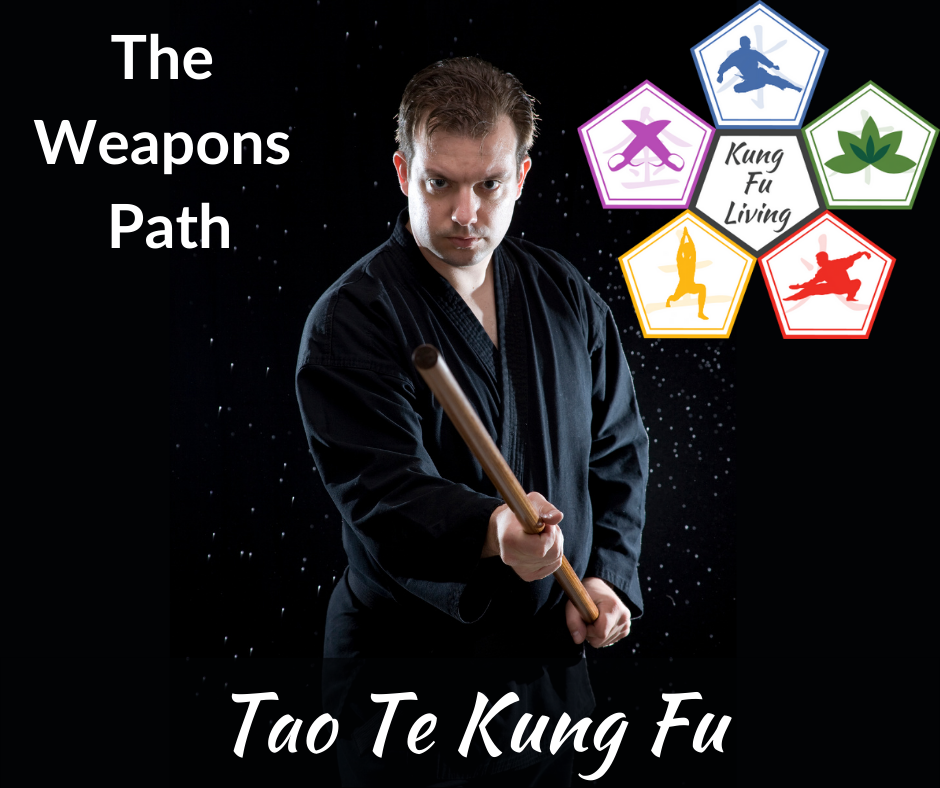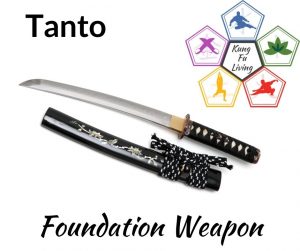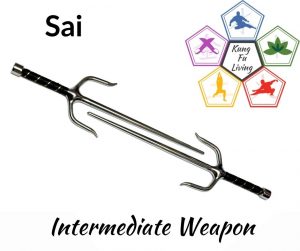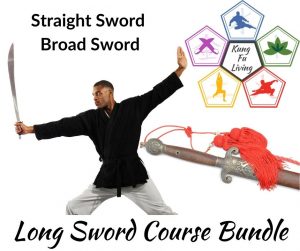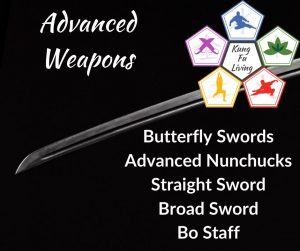This is the complete set of Tao Te Kung Fu containing all 13 martial arts weapons forms from beginner to advanced.
“Kung Fu – a passion pursued with discipline and a discipline pursued with passion.”
Kung Fu Living is a complete system that incorporates the most efficient techniques with modern teaching methods and takes advantage of the most recent developments in the neuroscience of skill acquisition.
Nunchuck
The nunchaku is one of the most widely used of the martial arts weapons, since it allows the development of quicker mind / body coordination and teaches 3 dimensional movements and patterns that also appear in unarmed kung fu combinations.
- The beginners or foundational nunchuck form performed with a single weapon
- How to bounce the nunchucks off your body for fast changes of direction
- Switching the weapon from one hand to the other with no pause in movements
- Spinning and figure-eight spinning in vertical and horizontal planes
Escrima Stick
While the Escrima stick has a particular heritage of techniques and has developed into a tournament style in itself. Please note the techniques taught here are for real life scenarios and not for simple point scoring in a sport. This difference will be evident to those with previous stick training as tournament techniques often involve delivering multiple fast, but light strikes that may not bring a real fight to a speedy resolution.
- The stick blocks, most often needed in real conflicts, used to create deflecting force
- The full set of strikes used in stick fighting and how to maximise their power
- How to step with the greatest speed and tactical effect
- The fastest single stick continuous striking techniques to overwhelm your opponent
- Use of the stick thrust for anatomically precise targeting and winning strategy
Tanto
The Tanto is perhaps the most obviously relevant of the martial arts weapons because a knife is the one weapon most easily available; we all tend to have a draw full of them in our kitchens. It is also the weapon an assailant is most likely to have.
- The primary deflecting blocks, most often needed in real conflicts
- The primary sweeping cuts with an understanding of their relative tactical strengths
- How to step with the greatest speed and tactical effect
- How to deliver a counter stab that is aimed at ending a confrontation with the greatest speed
- Tactical use of attacking your opponent’s knife arm and how to utilise optimal timing and targeting
Double Sticks
- The stick blocks, most often needed in real conflicts, used to create deflecting force
- The full set of strikes used in stick fighting and how to maximise their power
- How to step with the greatest speed and tactical effect
- The fastest double stick continuous striking techniques to overwhelm your opponent
- Tactical application of ambidextrous techniques to utilise optimal timing and targeting
- Use of the stick thrust for anatomically precise targeting and winning strategy
- The overall strategy for finishing any real fight in the shortest possible time for your safety
Double Tanto
- The primary deflecting blocks, most often needed in real conflicts
- The primary sweeping cuts with an understanding of their relative tactical strengths
- How to step with the greatest speed and tactical effect
- How to deliver a counter stab that is aimed at ending a confrontation with the greatest speed
- Tactical use of attacking your opponent’s knife arm and how to utilise optimal timing and targeting
- How to adapt your strategy and techniques to incorporate the use of two tantos for maximum effectiveness
- The overall strategy for finishing any real fight in the shortest possible time for your safety
Double Nunchuck
- How to bounce the nunchucks off your body for fast changes of direction
- Fast stepping and change of direction synchronized with complex spinning and striking techniques
- Spinning and figure-eights in vertical and horizontal planes
- How to effectively use symmetrical double strikes
Sai
The Sai are traditional Okinawan martial arts weapons consisting of one straight pointed prong, sometimes round, sometimes octagonal in section, with two sharp forward-pointing quillions.
They are not widely used in martial arts training but are very versatile, practical weapons with great flexibility for both defensive and offensive tactics.
Relatively cheap to make by being a simple iron or steel construction, they require no long forging process like good quality swords and are therefore likely to have been the weapon of commoners or peasants, a probability upheld by the fact that they can be easily carried. Hard plastic Sai are generally available for safer training and we indeed recommend that you learn with them.
The exact origin of the Sai are debatable but very likely originated in Okinawa.
Metal Sai are a relatively cheap weapon and are therefore easily available and once you have learned with the training Sai. Please be familiar with your own local law regarding the ownership of weapons.
- Sai single and double blocks often used to cover and defend larger areas of the body
- A figure 8 continuous attack sequence that includes stabbing and striking techniques. Used to overwhelm opponents.
- How to use the weight of the metal Sai to generate power and force in every strike
- Grip switches to allow you to change strategies and how you use the weapon
- How to step with the greatest speed and tactical effect
- Disarming techniques using the unique shape of the Sai and it’s quillions
- Use of the accurate thrust for anatomically precise targeting and winning strategy
- The overall strategy for finishing any real fight in the shortest possible time for your safety
Jo Staff
Tao Te Kung Fu is a complete system for real life combat. Of all the martial arts weapons, the Jo Staff is one of the most obviously relevant to most people’s lives, because a stick is a weapon often available, a longer walking stick or broom pole works perfectly well with these techniques.
While the Jo Staff has a particular heritage of techniques, it has developed, in some circles as a performance art or circus act, brilliant for what it is but no longer a martial art. Please note the techniques taught here are for real life scenarios and not for display purposes, no matter how visually pleasing. This difference will be evident to those with previous Jo Staff training as performance techniques often involve spinning and throwing, even juggling that, while being highly skilled, may not bring a real fight to a speedy resolution.
- The staff blocks, most often needed in real conflicts, used to create deflecting force
- The full set of strikes used in staff fighting and how to maximise their power
- The optimum redirecting blocks used tactically to open up your opponent for your counter strike
- Tactical application of ambidextrous techniques to utilise optimal timing and targeting
- Use of the staff thrust for anatomically precise targeting and winning strategy
- The overall strategy for finishing any real fight in the shortest possible time for your safety
Broadsword
The broadsword is unlikely to be something you will use in real self defence but the neurological patterns developed through learning this broadsword training program will augment all other weapons training and unarmed techniques. The use of continuous momentum is particularly vital in understanding how to use your own mass but also how to conserve your strength.
The broad sword is one of the most brutal martial arts weapons, designed to be used on a battlefield with a continuous sweep and circling cuts, nobody would want to get in its way. The trick with such a weapon is to conserve your energy (your training weapon is likely to be polypropylene or such, so won’t have the weight of the real thing). If you stop and start with this weapon you will soon get tired as every acceleration and deceleration will sap your strength, but if you can keep it flowing, letting its weight and momentum do the work for you, it will feel like all you have to do is steer it.
- The deflecting blocks that seamlessly integrate with the sweeping strikes
- The full set of strikes used in broadsword fighting and how to maximize their power
- The tactical use of continuous momentum to minimize effort and prioritize speed and efficiency
- Techniques to utilize optimal timing and targeting
- Specialized stepping and footwork techniques to best tactically use the momentum of the sword
- The overall strategy for finishing any real fight in the shortest possible time for your safety
Straight Sword
Of all the martial arts weapons, the straight sword is pre-eminent in developing good timing and speed of footwork. It enhances the intuitive exploitation of the openings in your opponent’s defence.
The straight sword is a fast and aggressive weapon principally developed as a gentleman’s dueling weapon. While never having any significant weight behind a strike it tends to flicker with deadly results. The prime defense with this sword is to deflect even as you attack yourself. You can perform all the straight sword techniques with a simple walking stick or cane, making this weapon form very adaptable.
- The light deflecting parries suited to the weight and speed of the weapon
- The full set of cuts and thrusts used in sword fighting and how to accurately apply them
- Techniques used tactically to open up your opponent for your counter strike
- Stance and fast footwork to optimize speed and timing
- Use of the straight thrust for anatomically precise targeting and winning strategy
- The overall strategy for finishing any real fight in the shortest possible time for your safety
Butterfly Swords
The butterfly swords develop fast, ambidextrous attacking skills and agile, multidirectional footwork. They teach you to aggressively close distance and overwhelm your opponents with speed and unpredictable attacks.
The Butterfly Swords are likely more formal versions of large Chinese meat cleavers, rather than military weapons. They are large bladed, top-heavy weapons that can deliver a powerful cleaving strike but are also effective at somewhat lighter cutting motions due to their shortness. Generally used in pairs, they are excellent close combat weapons thought to have been used by post-1800 civilian militia as they are easy to conceal and carry.
- The powerful double blocks used to defend against heavier, bigger weapons
- The full set of smooth and accurate cuts and thrusts used with these short aggressive swords
- Techniques used tactically to open up your opponent for your counter strikes
- Fast and multidirectional footwork to optimize speed and timing
- Use of the short blades to change cutting direction mid-strike to overwhelm your opponent’s defences
- The overall strategy for finishing any real fight in the shortest possible time for your safety
Bo Staff
The Bo staff is the weapon with the greatest reach advantage over any other weapon in the system. If used properly and with correct positioning, you can keep opponents at bay while delivering powerful attacks from a safe distance. The Bo staff is also held in a central grip in order to attack with both ends and overwhelm your opponent at a shorter distance. The two ways of staff fighting are comprehensively covered in this program.
The Bo staff has been used since the beginning of recorded history, often with a metal stud at the end. When used in real combat they tend to be on the heavier side. Many modern Bo staffs are no longer, really, martial arts weapons, being very light with tapered ends, they have become more a circus trick for aesthetic performance rather than martial combat. The lighter weight and size of the staff means it is easier to spin and throw. The Bo staff techniques taught in Tao Te Kung Fu are for fighting rather than performance and are done with a larger and heavier staff. Some techniques can also be practiced with a spear to a certain degree due to the similarity in the weapons.
- How to use the Bo Staff to shield your entire body
- Circular strikes from the long grip
- How to use circular strikes as redirecting blocks
- Powerful thrusts to different heights and targets
- Close grip blocking and striking techniques for close range
- Use of stepping to close range and engage close grip strategy
Advanced Double Nunchucks
- How to bounce the nunchucks off your body for fast changes of direction
- Spinning and figure eight spinning in vertical and horizontal planes
- The use of alternating double strikes
- Asymmetrical spins and figure eight spins with fast body spins and steps
- Complex figure eight spins while turning and transferring the strike directions
- Hand rolling nunchucks with both hands while constantly changing spin direction
You will need:
Some space, depending on the height of your ceiling, you might need to practice outside.
The appropriate practice weapons, we recommend you DO NOT learn these forms with real weapons.
These forms are short enough to be remembered (this is martial arts, not memory training), and should be practiced until they can be done without thinking.
The program is set out for you to train every day using several short videos. Adding to your skills in easy to follow steps, you will build superb skills that will become second nature.
Some videos are called Repeat Drills, these are of simple techniques that you need to learn so that you can do them without thinking. Once you press play, they will simply repeat continuously until you hit stop. This will enable you to practice each movement many times with a constant visual reference to help you get it right. You don’t want to practice until you get it right, you want to practice until you can’t get it wrong.
It is tempting to rush ahead, but you will find that to learn these skills thoroughly, it is best that you master each part as you go even if that means repeating the same day several times. Excellence takes patience and determination. Remember “Kung Fu” means “mastery through discipline.”

